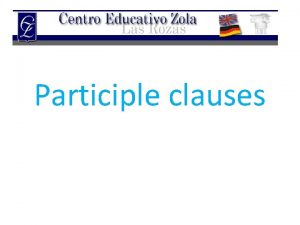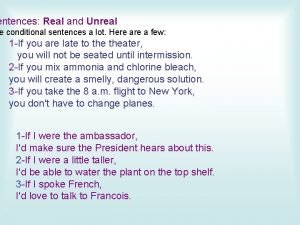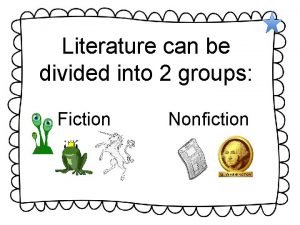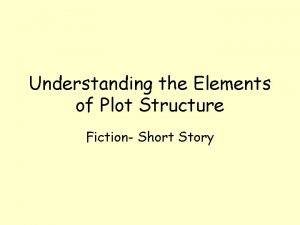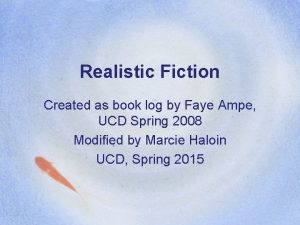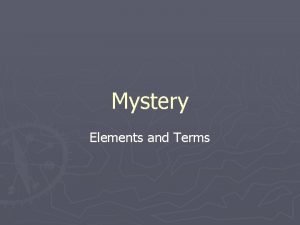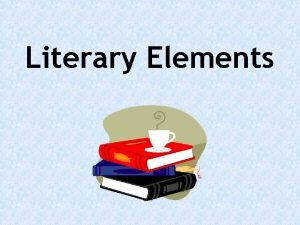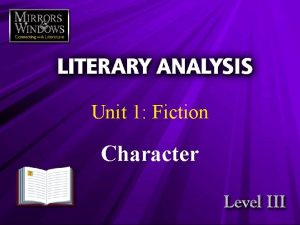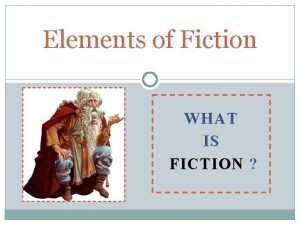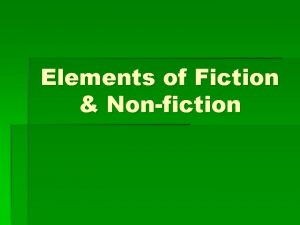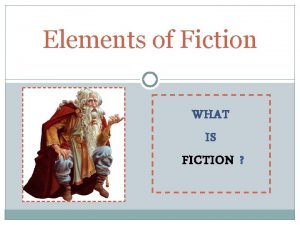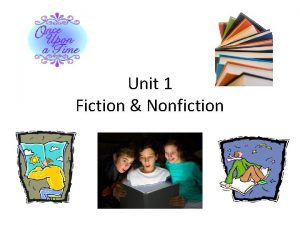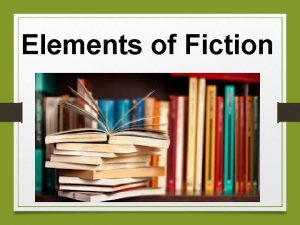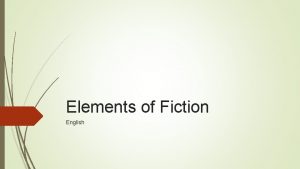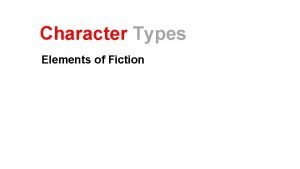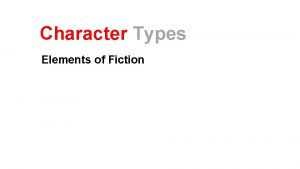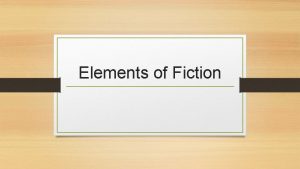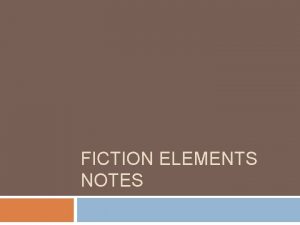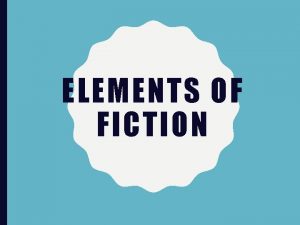ELEMENTS OF FICTION CHARACTER Ms Clouse 2017 DEFINING



















- Slides: 19

ELEMENTS OF FICTION: CHARACTER Ms. Clouse 2017

DEFINING CHARACTERIZATION Characterization is the process by which the writer reveals the personality of a character. Characterization is revealed through two methods: Direct Characterization tells the audience what the personality of the character is. “The patient boy and quiet girl were both well mannered and did not disobey their mother. Indirect Characterization shows things that reveal the personality of a character. These can be remembered by the acronym STEAL.

INDIRECT CHARACTERIZATION: STEAL Speech-What does the character say? How does the character speak? Thoughts-What is revealed through the character’s private thoughts and feelings? Effect on others-What is revealed through the character’s effects on other people? How do other characters feel or behave in relation to that character? Actions-What does the character do? How do they behave? Looks-What does the character look like? How does the character dress?

CREATING A CHARACTER ANALYSIS 1) Pay attention to the character’s ethics. Does the character make just or unjust choices? Consider Atticus Finch in Harper Lee’s To Kill a Mockingbird. Atticus does not make morally correct choices only when it is convenient for him to do so. Rather, he shows he’s a truly just character by sticking to his principles even when his life is at stake.

CHARACTER ANALYSIS 2) Decide whether the character’s actions are wise or unwise. For example, one may think of Friar Laurence in Shakespeare’s Romeo and Juliet as being a character who continually makes poor decisions that reflect his inner corruption.

CHARACTER ANALYSIS 3) What is the character’s motivation? As you are mulling over the pros and cons of each character’s internal thoughts and external actions, you will want to also consider why the character is acting or thinking in a particular way. Has the author given you any clues about the character’s past? In The Great Gatsby, Gatsby’s motivation for throwing parties is to try to get Daisy’s attention and therefore win her back. Also: The green light.

CHARACTER ANALYSIS 4) Consider the effects of the character’s behavior on other characters. When Ponyboy accidently kills a Soc, he and Johnny have to run away. Though they are Outsiders, Ponyboy and Johnny also save children from a burning building which eventually causes Johnny to die. Ponyboy realizes the importance of staying golden.

CHARACTER ANALYSIS 5) Look for repeatedly used words that describe the character. Those words often give insight into a character’s psychology and motivations. In John Steinbeck’s novel East of Eden, Kathy is frequently referred to as having “sharp little teeth” and a “flickering tongue, ” which are symbols of her snake-like monstrousness. (Also, consider Lennie (Of Mice and Men) and how he was often referred to being like a bear with big paws. )

CHARACTER ANALYSIS 6) Be aware of items associated with the character. They may something about his or her state of mind. A classic example is the delicate unicorn figurine in Tennessee Williams’ play The Glass Menagerie. The figurine is symbolic of Laura’s own sense of hope and her own fragility. Katniss and her bow Rosebud in Citizen Kane Comic book or superheroes

CHARACTER ANALYSIS 7) Read between the lines. Often what a character does not say is as important as what he or she does say. Think of Abner Snopes in William Faulkner’s short story “Barn Burning. ” When the court finds Snopes guilty of ruining his boss’ rug, prior knowledge of Abner’s character tells us that his silence upon hearing the verdict actually speaks volumes. We know he will react later. . . and violently.

CHARACTER ANALYSIS 8) Is the character “flat” or “round”? A character is considered flat (or static) when he or she does not experience change of any kind, does not grow from beginning to end. Shakespeare often uses comic villains as flat characters, like Don Jon in Much Ado About Nothing. Round characters are those who do experience some sort of growth, like Nora in Henrik Ibsen’s A Doll’s House. By the end of the play, she has gone from being meek and submissive to being strong and liberated.

CHARACTER ANALYSIS 9) Consider the historical time period of the character. Refrain from making modern judgments about the past; put the character’s actions and thoughts in context. A female character living in England in the 1800 s obviously could not make the choices that she could today, for both political and social reasons.

CHARACTER ANALYSIS 10) Finally, what does the author think? Look for any of the author’s own judgments about the characters he or she has created. The author may be directing you toward an intended interpretation. In The Scarlet Letter, Nathaniel Hawthorne certainly meant for his readers to see Hester as good and Chillingsworth as evil.

SPECIAL CONSIDERATIONS FOR POETRY Character-Refers to every being involved in the poem. Look for: 1. The Speaker 2. The Listener 3. Other characters who take an active role

THE SPEAKER The Speaker—is the mask or persona(e) a poet uses to tell the poem; it is very similar to a narrator in prose. All novelists do not make themselves the protagonist, nor do poets “force” the speaker to assume their identity. You should always assume that the poet and speaker are different unless there is clear evidence to the contrary.

THE SPEAKER One of the first things to decide in reading a poem is whether the speaker is inside or outside the poem. This determines the point of view used by the poet. The speaker is inside the poem if the point of view is first person. The speaker is outside the poem if the point of view is third person. How might these two different point of views change a poem? Why would a poet choose one over another?

THE LISTENER The Listener—is the person to whom a poem is addressed. Ultimately, of course, all poems are spoken to us, the readers, but poets can use a number of different strategies to do this. Speaker speaks directly to the reader, usually, using you. The listener, us, is clearly outside the poem. Speaker is speaking to him or herself and is not addressed to anyone or anything in particular. Here, the listener “overhears” the private thoughts of the speaker.

THE LISTENER Speaker speaks to a listener inside the poem, although the listener does not have to be human. It can be a character, object, or abstraction. Some modern poets use you, not referring to the reader nor an internal listener, but as an oblique or indirect way for the speaker to talk to/about him or herself.

OTHER CHARACTERS The Other Characters Poets also create characters who are neither speakers nor listeners. The speaker may describe other characters, tell what they have done, or even repeat what they have said. Just as in prose fiction, we cannot always accept the speaker’s presentation of another character at face value. Sometimes the speaker reports information about other characters without distortion; in other cases, however, we must be aware of the speaker’s attitudes and prejudices as we evaluate what he or she says about others.
 Past participle clause
Past participle clause 4 types of conditional sentences
4 types of conditional sentences Dan clouse
Dan clouse Element of nonfiction
Element of nonfiction Relative clauses defining
Relative clauses defining Relative clauses defining and non defining
Relative clauses defining and non defining Non defining relative clauses as sentence modifiers
Non defining relative clauses as sentence modifiers Defining and non defining relative clauses in telugu
Defining and non defining relative clauses in telugu Defining non defining farkı
Defining non defining farkı Defining non defining relative clauses
Defining non defining relative clauses Elements of fiction: character
Elements of fiction: character It is genre of speculative fiction
It is genre of speculative fiction Contemporary realistic fiction vs historical fiction
Contemporary realistic fiction vs historical fiction Fiction and non fiction examples
Fiction and non fiction examples What does it mean when a character is round or flat
What does it mean when a character is round or flat Plot structure of fiction
Plot structure of fiction The hello goodbye window summary
The hello goodbye window summary Characteristics of mystery flash fiction
Characteristics of mystery flash fiction Mystery elements
Mystery elements Elements of fiction short story
Elements of fiction short story
